Top speed 740 km/h Length 13 m | Wingspan 20 m First flight April 4, 2009 | |
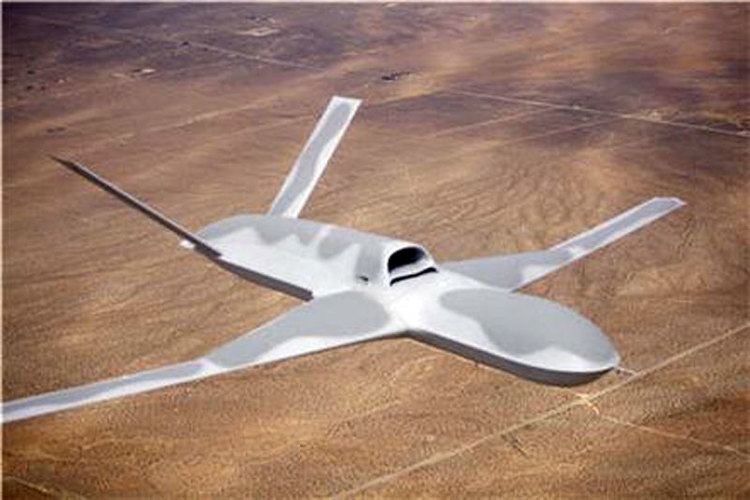 | ||
The General Atomics Avenger (formerly Predator C) is a developmental unmanned combat air vehicle built by General Atomics Aeronautical Systems for the U.S. military. Its first flight occurred on 4 April 2009. Unlike the previous MQ-1 Predator and MQ-9 Reaper (Predator B) drones, the Avenger is powered by a turbofan engine, and its design includes stealth features such as internal weapons storage, and an S-shaped exhaust for reduced infrared and radar signatures. The Avenger will support the same weapons as the MQ-9, and carry the Lynx synthetic aperture radar and a version of the F-35 Lightning II's electro-optical targeting system (EOTS), called the Advanced Low-observable Embedded Reconnaissance Targeting (ALERT) system. The Avenger will use the same ground support infrastructure as the MQ-1 and MQ-9, including the ground control station and existing communications networks.
Contents
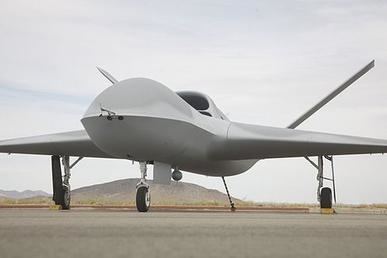
Flight testing
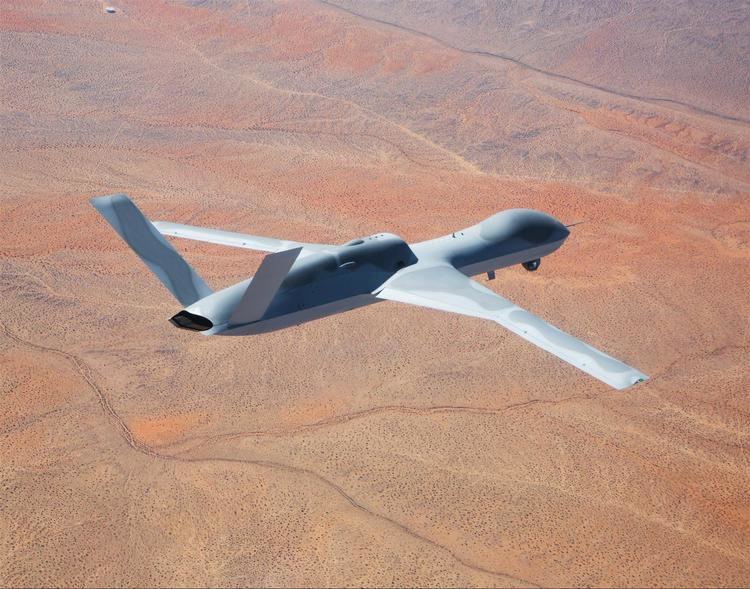
The first flight of the first prototype Avenger occurred on April 4, 2009 at the company’s Grey Butte Field Airport Flight Operations Facility in Palmdale, California. The aircraft took off and landed without any discrepancies and was ready to fly again once refueled. Following flights were performed successfully on April 13 and 14. The second prototype Avenger performed its first flight on January 12, 2012, meeting all performance objectives and refining the first prototype design to an operational capability. The Tail 2 prototype featured a four-foot longer fuselage to accommodate larger payloads and more fuel. This larger Avenger can carry a larger payload of up to 3,500 pounds (1,600 kg) of weapons internally and on its wing hard points.
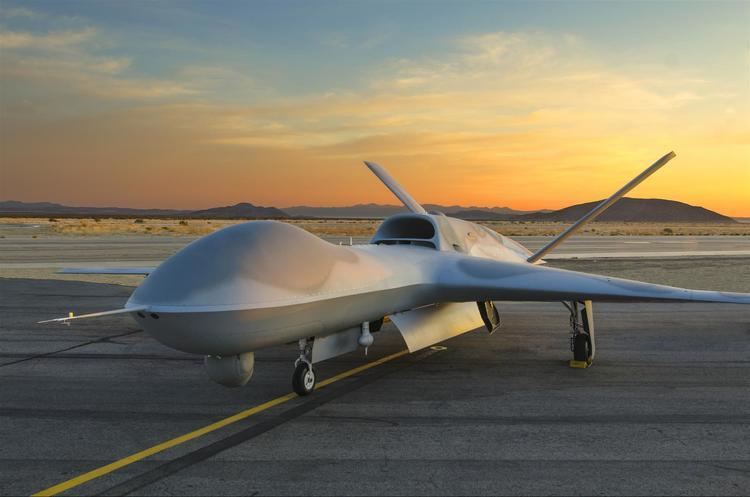
On February 15, 2012, the Air Force cancelled its MQ-X program, which was supposed to find an aircraft to replace the MQ-9 Reaper. The Sea Avenger variant is part of the Navy's Unmanned Carrier-Launched Airborne Surveillance and Strike (UCLASS) program. If it is selected by the Navy, the Air Force may consider buying the ground-based version for service.
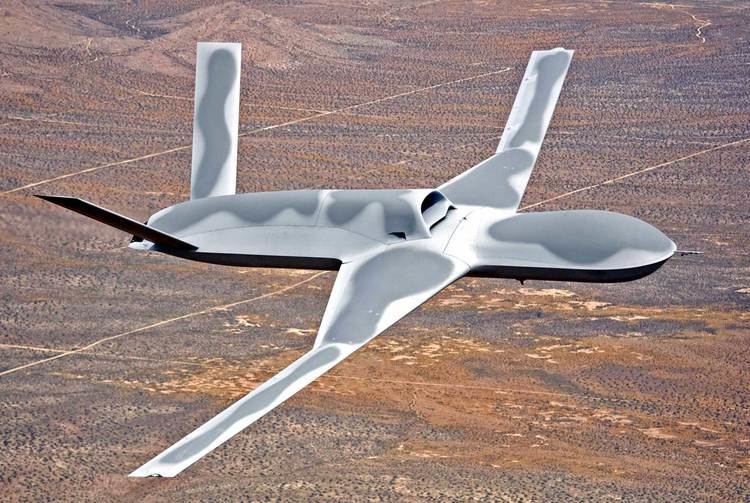
On November 15, 2012, the Avenger flew for three hours while being controlled by the General Atomics Advanced Cockpit Ground Control Station (GCS). The Advanced Cockpit GCS has a wrap-around visual display and multi-dimensional moving map to increase situational awareness and reduce pilot workload. The Advanced Cockpit GCS has flown an MQ-1 Predator and is planned to fly an MQ-9 Reaper as part of an Air Force initiative to enable interoperability with all USAF Remote Piloted Aircraft (RPA).
In July 2013, a third Avenger was scheduled to begin flight testing. Assembly of the fourth Avenger was expected to be finished by spring 2014.
On 27 October 2016, General Atomics flew an extended-range Avenger featuring wings extended by 3.2 m (10 ft) to 23.2 m (76 ft). The extended wings add about 1,000 kg (2,200 lb) of fuel totaling 4,600 kg (10,100 lb), extending endurance from 15 hours to 20 hours but reducing internal payload to 3,000 lb (1,400 kg). Since its first flight in 2009, the Avenger has completed more than 13,000 flight hours, reaching 11,000 hours in July 2016 and accumulating most of those hours within the past three years.
Potential deployments
In December 2011, it was reported that the Air Force had ordered an Avenger and that it would be deployed to Afghanistan. "This aircraft will be used as a test asset and will provide a significantly increased weapons and sensors payload capacity on an aircraft that will be able to fly to targets much more rapidly than the MQ-9 [Reaper] UAS," the USAF said in an announcement. "Since it has an internal weapons bay and four hardpoints on each wing it will also allow greater flexibility and will accommodate a large selection of next generation sensor and weapons payloads." The aircraft ordered was the original Tail 1 prototype version. This announcement sparked rumors that the aircraft would be deployed to monitor neighboring Iran and Pakistan. These allegations were made because the Avenger is stealthy, while the battlespace over Afghanistan is free of radar guided missiles, as well as any other anti-aircraft weapons. The announcement also came two weeks after the Iran-US RQ-170 incident. The Air Force responded by clarifying that the purchase was initiated in July of that year, well before the incident. However, the Air Force later clarified that the Avenger was being purchased only as a test asset, and that it was not being sent to Afghanistan. Discrepancies in the solicitation are believed to have caused the misinterpretation. After testing, the Air Force decided that the Avenger version they evaluated offered only modest improvements over the MQ-9 in terms of speed, payload, and reduced signature, and didn't meet survivability and reliability requirements to survive in contested environments needed to warrant buying a new aircraft of the type.
With the drawdown of the War in Afghanistan, the U.S. may lose airbases inside the country that are necessary for striking targets in neighboring Pakistan. Plans are being made to relocate drone bases to other countries in Central Asia to avoid needing U.S. military personnel to protect their bases in Afghanistan. Due to the longer distances from potential targets, General Atomics has pitched the Avenger to the Central Intelligence Agency as a better drone for the mission. The jet-powered Avenger can fly 1,800 mi (2,900 km) from its operating base and stay airborne for 18 hours.
On 26 October 2016, the General Atomics vice president revealed that the Avenger was used to conduct a leaflet drop in Syria.
Export
General Atomics has offered the Predator C Avenger to Canada as a contender for its Joint Unmanned Surveillance and Target Acquisition System (JUSTAS) armed UAV project. In 2016, the JUSTAS project was prioritized by the Royal Canadian Air Force and Liberal government. The RCAF has requested that the drones be armed, therefore making the General Atomics Avenger the only suitable contender as Northrop Grumman's RQ-4 'Arctic Hawk' is unarmed.
On 22 September 2015, the U.S. stated they backed India's membership in the Missile Technology Control Regime, which would enable them to buy armed drones. Two days later, the Indian Air Force sent a letter to General Atomics saying it wanted to purchase the Avenger. The Avenger would allow the IAF to reach all of Pakistan, enabling them to retaliate against Pakistan-based terrorists without the risk of losing pilots. It could also be useful as a deterrent during border disputes with China.
Sea Avenger
On 3 May 2010, General Atomics Aeronautical Systems, Inc. (GA-ASI) introduced Sea Avenger, a carrier-based derivative of the Predator C Avenger UAS, intended to fulfill the U.S. Navy’s need for an Unmanned Carrier-Launched Airborne Surveillance and Strike (UCLASS). The company formally proposed Sea Avenger to the Naval Air Systems Command via a request for information submitted on 30 April 2010.
The Sea Avenger includes a retractable electro-optical/infrared sensor, internal weapons bay, and folding wings. The aircraft’s structure was designed with the flexibility to accommodate carrier suitable landing gear, tailhook, drag devices, and other provisions for carrier operations.
On February 15, 2011, General Atomics announced that they had successfully completed a key wind tunnel test on a model of the Sea Avenger. The goal of the test was to validate the low-speed characteristics of an updated wing in the approach, launch, and cruise configurations. The advanced design utilizes proprietary wing technology that enables high-speed flight, while also supporting excellent low-speed handling qualities desired for aircraft carrier landings. The tests took 90 hours and were performed over eight days, which were completed ahead of schedule. The wind tunnel test validated the low-speed characteristics of a new wing, resulting in higher endurance and lower approach speeds. The new wing is also designed to increase aircraft dash speeds, decreasing the time to respond to potential threats.
On 14 August 2013, General Atomics was awarded a $15 million contract to develop the airframe of their UCLASS entry. Contracts of the same amount were awarded to Boeing, Lockheed Martin, and Northrop Grumman for their competing designs. A competition for a final airframe design was expected after January 2014, but has been delayed until sometime in 2016.
In April 2014, General Atomics displayed images of the Sea Avenger at the Navy League Sea Air and Space exposition. As requirements for the UCLASS program were altered from a high-end strike aircraft to an ISR machine operating in permissive environments, the Sea Avenger was modified accordingly. It appears to have four external hardpoints and a small weapons bay, a wing-mounted buddy-refueling store to perform as an aerial tanker, and a larger airframe with a larger engine. If Navy requirements favor a UAV optimized for permissive ISR over broadband stealth, the Sea Avenger may better meet them, as it was originally pitched as having a reduced signature to be "stealthier" than other aircraft. Broadband stealth that is effective against low-frequency radar bands like VHF and UHF usually are present in a flying wing design. Sea Avenger stealth capabilities seem to be limited to higher frequencies like C, X, and Ku bands. General Atomics and Boeing are offering UCLASS wing-body-tail concepts optimized for modest threat environments, while Lockheed and Northrop Grumman are going for full broadband stealth flying-wing designs.
Specifications
Data from
General characteristics
Performance
Armament
Internal weapons bay with 3,500 pounds (1,600 kg) capacity. 6 external hardpoints. 6,500 pounds (2,900 kg) payload total.
Avionics
